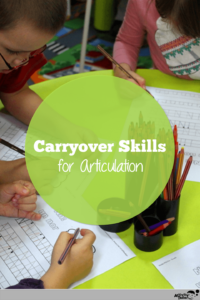Kids often get stuck in therapy. They can make a sound (or sounds) in structured activities but need help to move beyond that. The answer to this dilemma is they are lacking in CARRYOVER. Implementing carryover activities in articulation therapy is essential, and they don’t have to be difficult either!
Try these 4 tried-and-true strategies for effective carryover in your articulation therapy sessions TODAY!
Start Early!
First thing’s first– know that you should start addressing carryover skills as soon as possible!
By implementing carryover strategies in small chunks over the entire course of a child’s therapy journey, you’re instilling self-confidence and self-belief while providing infinitely more opportunities for a child to practice targeted speech sounds!
4 Strategies for Effective Carryover of Articulation Skills
There are four tried-and-true strategies to target the carryover of articulation skills:
- Focus on fewer words
- Focus on one word outside of therapy
- Practice sounds in naturally fun ways
- Short daily practice
Focus on Fewer Words
Although this almost feels counterintuitive, working on fewer words in articulation therapy sessions has been proven to be helpful for better carryover. With fewer words, kids can learn to produce these correctly and automatically!
These correct productions will act as positive reinforcement and a confidence boost for your students. Confidence leads to children being more likely to try new things (or in this case, new words and new places!) win, win!
Focus on One Word Outside of Therapy
Select one word for your child to focus on producing correctly outside of therapy.
This strategy drastically removes the pressure off students and helps parents listen to particular speech sounds more easily. Children are also able to take more ownership when responsible for a single word vs a sound that might occur in many, many words.
Make It Personal!
Select a target word that comes up often in conversation for each student and focus on that one word outside of therapy.
It doesn’t make sense to select a random word with the child’s target sound because they just won’t say it enough in real life (think: “tallow” for /t/ or “kneel” for /l/).
Personalized Examples:
“ok” for /k/
a child’s name
“School” for sk- blend
“Football” for /f/
“Gigi” for /g/
Practice Sounds in Naturally Fun Ways
Use a game or activity that naturally incorporates your child’s targeted sound or word for lots of easy practice!
Example:
The game Guess Who has many opportunities to practice /r/
- “Is your person a girl?”
- “Does he have red hair?”
- “Do you want red or blue?”
Short Daily Practice
Get parents and teachers on board!
Encourage them to designate short bits of time to work on corrections in students’ conversations each day. Five minutes is the MAX recommended time for this strategy!
EXPERT TIP: Model this type of interaction and instruction for teachers and families. You can do this in person with the child, or you can tap into technology and send a video explaining what this daily practice looks like.
Reassure adults in the child’s life that YES, they CAN devote 2-5 minutes each day to practice!
Use Resources
Premade resources are another great way to do a short daily practice with students.
This Rock Paper Scissors Carryover Game is perfect for targeting /s, z, th/ in phrases and sentences. The cards are organized into sound and position for EASY USE.
It seems like lots of students struggle with their carryover of /r/, and this Rock Paper Scissors Carryover Game addresses just that! Your students will have so much fun with these games that they won’t even realize you’re getting practically a million trials in too!
For kids with sound errors for /r, s, th, sh, ch/, this Articulation Worksheets BUNDLE is perfect! These fill-in-the-blank stories allow your students to create silly & goofy stories that they will love reading over and over again— all while practicing their articulation targets!
Looking for More?
Parent Education Handouts for Speech Sound Disorders covers thirteen topics including tips for carry-over! Use these print-and-go (or email) one pagers to strengthen the connection between therapy and home and watch how quickly your students progress!
Putting Play to Work is a two-hour webinar that will equip you with more knowledge about the importance of play for little ones and how you can use objects and toys in a child’s environment to target speech and language goals. Activity ideas are also included for articulation therapy sessions!
You may also be interested in reading:
Understanding Pop-Out Words in Speech and What They Mean for My Child
MUST-KNOW information about phonemic awareness and speech sound disorders
Typical Development of Phonemic Awareness Skills + How to Target Them







